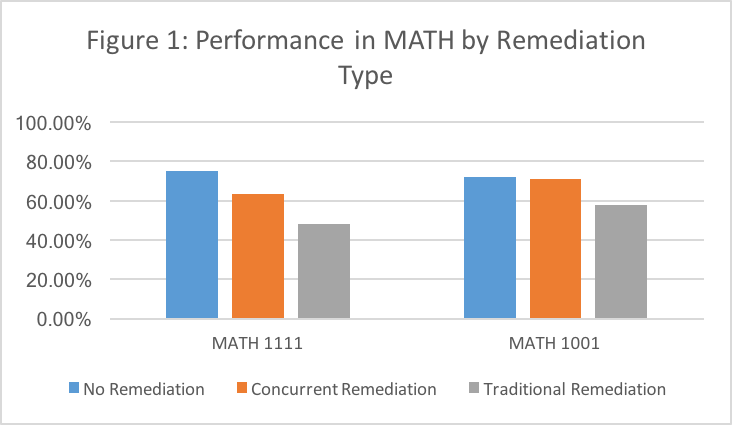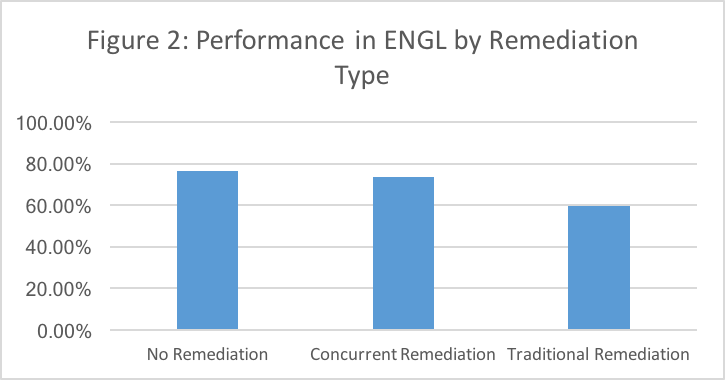GGC has continued to invest heavily in developing and offering remediation through a concurrent delivery model to qualified students. Developed by faculty, the model is based on successful models such as the Accelerated Learning Program used by Baltimore Community College. The College has successfully implemented programs for English (Segue English) and mathematics (ACCESS Math), pairing co-requisite remedial support and instruction with the appropriate college-level class. Starting the 2014-15 academic year, GGC offered courses pairing remedial support in reading and writing with ENGL 1101, thus making concurrent remediation available to an expanded population of students. While recent changes in USG policy regarding remediation combine foundation-level reading remediation with English, the investment in planning and curriculum development has proven useful in improving the framework for future concurrent remediation in English. Effective, well-designed concurrent remediation options are expected to lead to increased academic success and confidence and increased retention in academically underprepared students.
GGC also has invested significantly in designing and using block scheduling as a strategy. GGC began offering block schedules to incoming full-time first-time students on a voluntary basis in Fall 2012 with 40 course blocks available. With preliminary data showing a positive impact on academic performance and retention, the College again offered 40 course blocks to incoming students on a voluntary basis in Fall 2013. In these two semesters, students were informed of the option to select a course block at the time of registration and were given a list of available choices. Students self-selected a course block and were enrolled in those courses by the Registrar’s office staff. Data from Fall 2012 again showed a strong positive impact of block enrollment.
Because early data from the College’s pilot efforts with block scheduling indicated that this strategy supports success for the GGC student population, the College expanded its efforts in Fall 2014 and enrolled all first-time, full-time students with less than 12 hours of prior college credit in block schedules. This expansion was successful, and GGC is continuing this investment. During the 2015-16 academic year, specific activities have continued to focus on improving communication with students about their options and the rationale behind the course assignments.
Further, the College has begun to develop a framework for more integrated planning and instruction across the courses to form strong learning communities.
Progress for these efforts is measured by tracking the number of sections offered, which provides a measure of the number of students served. GGC has increased its investment in concurrent remediation each year, moving from 12 sections of Segue English and 8 of ACCESS Math in 2012-13 to 17 sections of Segue English and 18 sections of ACCESS Math in 2014-15. Further, during the 2014-15 academic year, GGC prepared to increase the scope of this initiative in compliance with new policies of the University System of Georgia. For Fall 2015, the College had 23 sections of Segue English, serving over 360 students. For learning support Math, the College offered 25 sections of concurrent remediation aligned with MATH 1001 (for non-STEM track students) and 32 sections aligned with MATH 1111 (for STEM track or Undecided students). Table 9 tracks the growth of co-requisite course offerings over the past two years. We expect growth in the upcoming year proportional to the overall growth of the student population.
Table 9: Implementation of Co-requisite Remediation Over 2 Years
|
Concurrent Remediation Course |
FA 2015# sections |
FA 2015 enrollment |
FA 2016 # sections |
FA 2016 enrollment |
||
|
ENGL0099 (Segue) |
24 |
294 |
57% |
34 |
399 |
60% |
|
ENGL0989 (Foundation) |
17 |
218 |
43% |
19 |
267 |
40% |
|
ENGL LS Total |
512 |
666 |
||||
|
MATH 0997 (Access) |
12 |
182 |
18 |
284 |
||
|
MATH 0999 (Access) |
15 |
259 |
22 |
406 |
||
|
Total concurrent MATH |
441 |
48.8% |
40 |
690 |
52.6 |
|
|
MATH 0987 |
19 |
276 |
21 |
328 |
||
|
MATH 0989 |
11 |
187 |
16 |
295 |
||
|
Total Foundation MATH |
463 |
51.2% |
623 |
47.4% |
A second measure of progress for co-requisite remediation is the number of faculty in each discipline prepared to teach the courses. This number has increased over time as additional faculty are trained or hired with the appropriate skills and background to teach and engage with students in co-requisite courses effectively. An example of this effort is the specific training provided by faculty leaders in the English discipline for colleagues teaching the ENGL 0099 Segue courses. In the Math discipline, the effort is bolstered by the purposeful hiring of those with appropriate teaching experience and skills that will serve well in or be adaptable to the co-requisite classroom. Finally, the School of Transitional Studies is currently investigating creating a faculty professional development series on best practices in learning support pedagogy in conjunction with GGC’s Center for Teaching Excellence badging initiative.
Basic activity and output measures are also used to track progress in implementation of block schedules and learning communities. As noted above, the College offered 40 course blocks in the Fall semester of 2012 and 2013 during its pilot implementation and test of this strategy. For the full implementation in Fall 2014, 122 course blocks were prepared based on 20 different possible configurations derived from meta-majors and learning support placement options, providing spaces for 2520 students in course blocks. For Fall 2015, there are 28 course configurations derived from the meta-majors and learning support placement options. This provides spaces for up to 2557 students. As of August 1st, 2207 students were enrolled in blocks.
Measures of Success
The critical measure of success for co-requisite remediation is the overall success of the students, both immediately in the Learning Support and college-level courses and in subsequent related classes. The results from the early implementation showed that students in the Segue English and ACCESS Math classes were able to exit Learning Support at higher rates than their peers in traditional Learning Support and passed ENGL 1101 and MATH 1111 at comparable rates to their non-Learning Support peers. Subsequent years have produced comparable results. For the 2015-16 academic year, the data continued to show that students in the Segue and ACCESS classes perform well. Figures 1 and 2 show that students in the concurrent remediation classes successfully completed ENGL 1101 and MATH 1001 at rates comparable to their peers who did not require remediation and substantially higher than their peers who completed a traditional sequence of remediation followed by the credit-bearing class. In MATH 1111, students in concurrent remediation successfully completed the class at a rate mid-way between their peers who did not require remediation and those who completed the traditional sequence. In the 2015-16 academic year, about 60% of students exited ENGL 1101 after having completed a traditional (non-concurrent, or foundational) remedial English class, whereas about 74% of students who enrolled in ENGL 1101 while in a concurrent co-requisite remedial ENGL 0099 section exited successfully. For MATH 1111, about 63% of students enrolled in concurrent co-requisite remediation successfully exited the Gateway course compared to 48% who had completed a traditional remedial course. For MATH 1001, the percentage passing for concurrent and traditional remediation were 71% and 58% respectively.
These same data document high success rates in the learning support courses as successful completion of the credit-bearing class documents successful exit of the learning support requirement. As GGC increases enrollment in concurrent remediation, the target for success metrics is to maintain performance of students in concurrent remediation at the same level as performance of non-remedial students.
As noted earlier, the block schedules are predicted to yield improvements in academic success and retention for enrolled students. It is difficult to identify specific baseline data for this strategy in part because GGC is implementing several overlapping strategies that impact the same students.However, for Fall 2012 and Fall 2013 students, some analysis is possible because not all incoming students were enrolled in blocks. A comparison of those in blocks to those not in blocks showed that the students in blocks had both higher GPAs and higher retention rates than students not in blocks. Data for the Fall 2014 student cohort are compared to the data for the Fall 2013 cohort and shown in Table 10. While the results suggest that a portion of the pilot results were related to self-selection of students into blocks, the ongoing data nevertheless show both a clear positive impact of the blocks on GPA and retention and, to some extent, a persistent impact on student success and retention.
Table 10: Block vs Non-block Academic Performance and Retention for Fall 2013, Fall 2014, and Fall 2015 Cohorts
|
N: First-time, full-time freshmen |
Mean Fall GPA |
Mean Fall credit hours passed |
First semester retention rate (N) |
Spring Cumulative GPA |
Spring credit hours passed |
First year retention (N) |
|
|
In block Fall 2013 |
744 |
2.70 |
13.23 |
91% (678) |
2.66 |
13.18 |
71.6% (533) |
|
Not in block Fall 2013 |
1225 |
2.44 |
12.07 |
86.5% (1060) |
2.42 |
12.55 |
62.4% (765) |
|
Fall 2014 |
2121 |
2.48 |
11.64 |
90% (1910) |
2.51 |
10.96 |
68.0% (1442) |
|
Fall 2015 |
2008 |
2.47 |
11.67 |
88% (1774) |
2.50 |
10.99 |
These data demonstrate that these are impactful strategies contributing to our overall success in maintaining strong early success and first-year retention rates in a high-need, under-prepared population. The primary challenge for GGC in implementation continues to be one of capacity building. While our data show that these efforts are successful and there is a need to grow the programs to serve more students, there are significant costs associated with hiring and preparing sufficient faculty to maintain implementation fidelity as these efforts scale up.
As learning support continues to change throughout the University System of Georgia, GGC anticipates our programs will continue to grow and evolve in order to effectively meet the needs of our unique student population. The move toward increased numbers of co-requisite learning support offerings and more tailored options for STEM and non-STEM track students with respect to remedial mathematics should continue to enhance the opportunity for success among GGC’s less prepared first-year students. In the year ahead, careful measurement of student success rates will be taken. Similarly, the move toward integrating instruction across block schedule courses to create strong learning communities will strengthen these efforts.
One additional area of development that will assist in the personal and academic development of our first-year students is the reinstatement and scaling-up of a robust first-year seminar, GGC 1000. This extended orientation model one credit course will help students successfully work through the academic and personal transitions attendant upon their enrollment in and progression through college. The FYS will build upon information and themes stressed in Bear Essentials orientation sessions, have students practice skills for academic and personal well-being, and give them a foundational understanding of major and career planning.
While the first-to-second year retention rate for incoming first-year students at GGC currently approaches 70%, it is believed that reinstating a FYS (and other first-year experiences such as learning communities) will only improve this rate. More importantly, it will promote in students the skills and habits of mind that will strengthen their abilities both to understand college culture and successfully navigate any challenges they face in years 2-4; this thereby will help them more effectively progress to graduation. GGC is a champion of providing students the support and mentoring they need to be successful. The first-year seminar and other first-year programming efforts are integral to that mission. A pilot of GGC 1000 is planned for Spring 2017, with possible integration into learning community models to follow.



